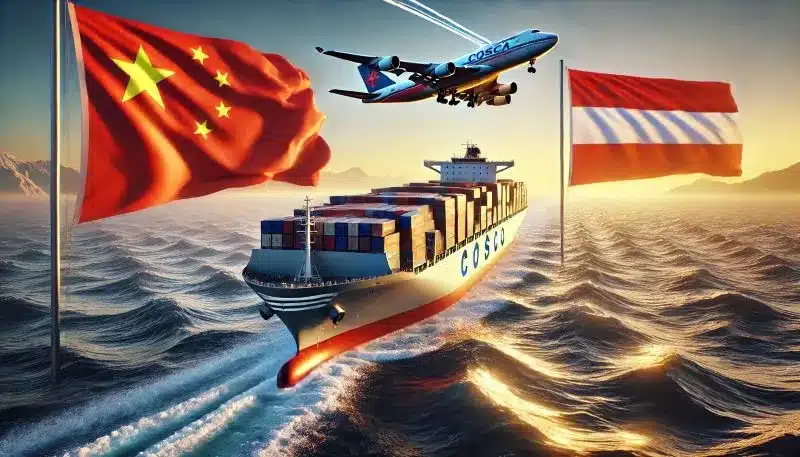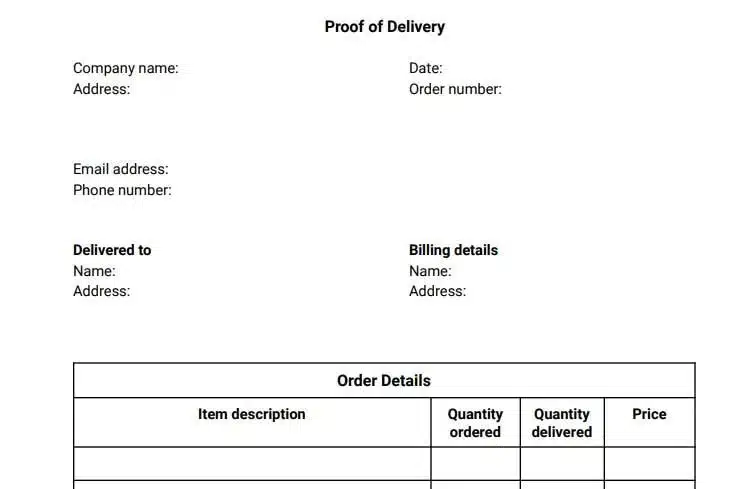Austria is an important trading partner of China in Central Europe. Its main imports include machinery, equipment, electronic products, textiles, furniture, and auto parts. Transportation costs become particularly important for many novices who want to engage in Sino-Austrian trade. This article will explain in detail.

Why import from China?
- Manufacturing base: China is the world’s largest manufacturing center, offering diverse export goods.
- Multiple shipping options: Ocean Freight, Air Freight, and Rail Freight are available to suit different needs.
- Trade agreements: China has a Free Trade Agreement with the EU, which reduces tariffs and logistical costs.
- Cost advantages: Manufacturing in China is relatively low-cost, reducing factory and shipping costs.
The main transport methods from China to Austria are
Ocean Freight
It is the most cost-effective shipping method and is especially suitable for transporting large goods.
- Shipping methods: FCL (full container load) and LCL (less than container load). FCL is suitable for situations where the volume of goods is sufficient to fill a container and can better protect the safety and integrity of the goods; LCL is ideal for small quantities of goods, with goods from multiple owners being shipped together in a container.
- Transit time: It takes about 30-50 days, depending on the port of departure and destination and various factors during the journey, such as weather, customs inspections, etc.
- Applicable cargo types: Suitable for bulky goods, industrial equipment, furniture, and other bulky and heavy goods that do not require a particularly urgent transit time.
Air Freight
The fastest, suitable for transporting high-value goods.
- Transport time: Usually 3-7 days, but if there is a direct flight, the transport time will be shorter, which is very suitable for transporting goods that require a speedy transit time.
- Applicable cargo types: Electronic products, luxury goods, fresh food, etc., sensitive to transit time, have a high product value, and can bear higher freight costs.
Rail transport
The transport speed is moderate, and the cost is relatively mild.
- Transport time: Generally, it takes 15-25 days, a much shorter transport cycle than Ocean Freight, and a lower cost than Air Freight.
- Applicable Cargo Types: Suitable for medium-volume cargo transport, with a high cost-effectiveness ratio when considering transport time and cost.
3. Calculation of shipping costs
Shipping costs include several different fees:
- Basic Shipping Fee: Calculated according to the respective billing standards for the selected shipping method: Ocean Freight, Air Freight, or Rail Freight.
- Fuel Surcharge: Commonly found in Air Freight and Ocean Freight, this fee is adjusted according to fluctuations in the international oil price to compensate for changes in fuel costs during the shipping process.
- Customs clearance fees and destination port clearance fees: Customs clearance fees are incurred when goods are declared to the Chinese customs when they are exported, while destination port clearance fees are those incurred when goods arrive in Austria and go through customs clearance procedures at the local customs.
- Port miscellaneous fees: These cover terminal handling charges, storage fees, pick-up fees, and others that vary from port to port.
- Customs duties and VAT: Austrian customs policy levies customs duties according to the type and value of goods. The VAT rate in Austria is about 20%.
- Insurance costs: generally charged at 0.3% – 1% of the value of the goods, to protect the goods during transport and reduce transport risks.
You can roughly estimate the total shipping cost using the formula ‘FOB + freight + customs duties + other miscellaneous fees = total cost.’
Factors affecting rates
- Mode of transport: Ocean Freight is relatively inexpensive, Air Freight is the most expensive, and Rail Freight is in the middle. The difference in rates between the various modes of transport is mainly due to differences in transport speed, transport capacity, and operating costs.
- Type of goods: Dangerous goods, fragile goods, oversized goods, etc., will have higher transport rates due to the higher difficulty and risk of transport. For example, transporting dangerous goods requires special packaging, equipment, and safety measures, increasing transport costs.
- Seasonal factors: During peak seasons, such as Christmas and the post-Singles’ Day period, freight rates usually rise due to the substantial increase in transport demand and limited transport resources.
- International oil prices and fuel surcharges: Fluctuations in global oil prices directly affect the level of fuel surcharges, affecting transport costs. When oil prices rise, fuel surcharges will also increase.
- Destination port/airport and local costs: Different destination ports/airports and local logistics environments can lead to different local costs. For example, large cities such as Vienna have relatively high costs due to high logistics demand and infrastructure costs.
Shipping Cost from China to Austria
Sea Freight Cost from China to Austria
Standard sea freight routes are from major Chinese ports such as Ningbo, Shanghai, Shenzhen, Guangzhou, etc., to Hamburg, Germany, and then transshipment to Austria via land transport.
| POL (port of loading) | POD (port of discharge) | LCL shipping cost | 20ft container cost | 40ft container cost |
|---|---|---|---|---|
| Shanghai | Hamburg | $85-$160 | $2050-$3050 | $3000-$4900 |
| Shenzhen | Hamburg | $70-$145 | $1900-$2900 | $3050-$4850 |
| Qingdao | Hamburg | $90-$140 | $1950-$2950 | $3050-$4750 |
| Ningbo | Hamburg | $85-$150 | $2000-$3000 | $3150-$4850 |
| Shanghai | Trieste | $70-$145 | $1950-$2850 | $3050-$4700 |
| Shenzhen | Trieste | $80-$155 | $1800-$2800 | $3100-$4800 |
| Qingdao | Trieste | $90-$165 | $2050-$2950 | $3050-$4750 |
| Ningbo | Trieste | $85-$145 | $2000-$2950 | $2950-$4850 |
Air Freight Cost from China to Austria
Applicable to urgent or high-value cargo, flying directly from major airports in China (such as Shanghai, Guangzhou, Shenzhen, Beijing) to Vienna International Airport (VIE), usually charged based on the larger of actual weight and volumetric weight (length cm × width cm × height cm ÷ 6000).
| Departure Airport (China) | Arrival Airport (Austria) | Cost Per KG (USD) |
|---|---|---|
| Shanghai Pudong | Vienna | $5.80 – $8.50 |
| Guangzhou Baiyun | Vienna | $5.00 – $9.60 |
| Shenzhen Bao’an | Vienna | $5.90 – $8.40 |
| Beijing Capital | Vienna | $5.10 – $8.70 |
| Hong Kong | Vienna | $5.70 – $9.20 |
Rail Freight Cost from China to Austria
It is suitable for the transportation of goods with faster timeliness and lower cost, usually via the China-Europe Express and finally arriving in Vienna, Austria. The fee is charged according to LCL and FCL, and the fee range is as follows:
| Departure City(China) | Arrival City(Austria) | LCL Shipping Cost | FCL Shipping Cost |
|---|---|---|---|
| Chengdu | Vienna | $150 – $250 / CBM | $6000-$7500 /40FT |
| Chongqing | Vienna | $160 – $230 / CBM | $6100-$7800 /40FT |
| Xi’an | Vienna | $170 – $240 / CBM | $6000-$7600 /40FT |
| Chengdu | Linz | $150 – $240 / CBM | $6200-$7950 /40FT |
| Chongqing | Linz | $170 – $250 / CBM | $6150-$7980 /40FT |
| Xi’an | Linz | $160 – $240 / CBM | $6000-$78000 /40FT |
| Chengdu | Graz | $150 – $250 / CBM | $6100-$7800 /40FT |
| Chongqing | Graz | $150 – $240 / CBM | $6150-$7980 /40FT |
| Xi’an | Graz | $160 – $230 / CBM | $6000-$7500 /40FT |
Breakdown of Ocean Freight Transport Costs
- Ocean Freight (Basic Freight): Basic transport costs are determined according to container type and route.
- Port Charges: Including loading and unloading charges and wharfage fees for cargoes at ports, which are charges for port operations and services.
- Bunker Addition Fee (BAF): Used to compensate for the increase in cost brought about by changes in fuel prices during Ocean Freight.
- Customs Brokerage and Destination Clearance Fees: Fees related to processing customs declarations for the import and export of goods and clearing of goods at the port of destination.
- Customs duties and VAT: By Austrian customs regulations, customs duties and a value-added tax (VAT) of around 20 percent are levied on imported goods.
- Inland transport costs Are the costs incurred for transferring goods from a transit port such as Hamburg, Germany, to a destination in Austria.
Tips to reduce transport costs
- Choose economic mode of transport: For small quantities of goods, LCL (Less than Container Load) has more cost advantages than FCL (Full Container Load), which can effectively reduce the unit transport cost.
- Reasonable planning of freight time: Try to avoid the peak season, such as November – December, when the demand for transport is strong and the freight rate is often higher. Choose to transport in the off-season; you can get a more favorable price.
- Optimise packaging: Design the packaging appropriately to reduce transport costs, reduce the size of the goods, and avoid overweight situations. For example, use lightweight and strong packaging materials and rationally arrange the space for cargo placement.
- Compare quotations from several freight forwarders: Different freight forwarders offer different service quality and prices. You can choose the partner with the best price/performance ratio by consulting and comparing quotations from several freight forwarders.
- Choose CIF or FOB terms: According to the actual business situation, carefully analyze and choose the most suitable trade terms: under CIF (Cost, Insurance, and Freight) terms, the seller is responsible for transport and insurance; under FOB (Free On Board) terms, the buyer is responsible for arranging transport. Choosing the proper terms helps to control transport costs.




